
We have recently relaunched our Behind the Screens feature, offering readers a chance to see where we work everyday and the gear we use to do it. Rikka gave us an in-depth look at a colorful and inspiring MacBook setup last week, and now it’s my turn. Centered around a Mac mini and a more than modest display, my setup focuses on high-quality audio, saving money wherever possible elsewhere, and a generally natural, minimalist, and organic design approach.
Behind the Screens is a new weekly 9to5Toys series that takes you through our writers’ setups. Including everything from workstations to battlestations, on-the-go setups, home theaters, and gaming rigs, we take a look at all of the gear that gets daily use in our lives. Next up its Justin Kahn.
Justin’s at-home workstation
When it comes to my personal setup and gear choices, a few obvious trends begin to emerge; Higher quality gear that will last the test of time over the latest and greatest (where possible), spending cash where it really matters (to me), and a focus on music production (to some degree).
I tend to do most of my work from a small home office – a beaten-up and characterful faded Persian-style rug on the hardwood floor, as much natural foliage as possible, wooden tabletops and trays, with mostly black or darker color gear throughout as of right now, all set upon a minimalist and plain off-white backdrop.
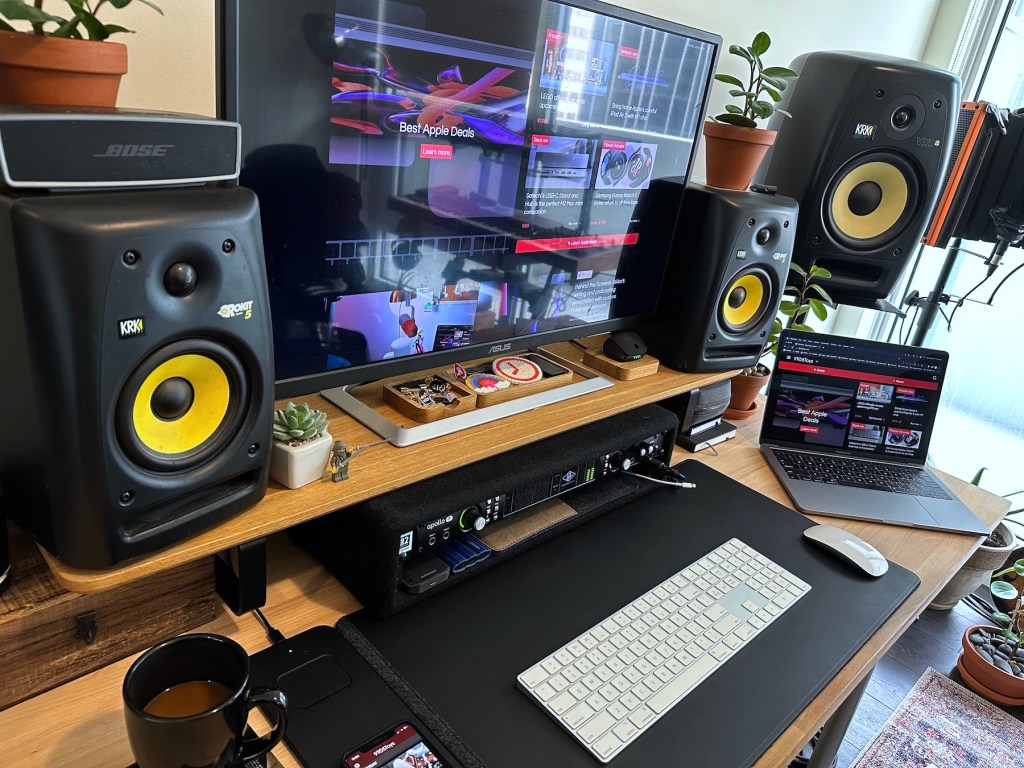
I am admittedly going to be moving spaces in the next year or so and have held off on making too many purchases towards workspace upgrades before then and have trimmed things back in the last several months in preparation, but you can likely expect a move over to darker walnut-like color woods, the investment in a more permanent desk – you know the kind that will last a lifetime – and some interesting wall art/treatments that suit the overall classic/natural meets home studio vibe.
Computers
As I mentioned above, I’m not much for working on the go, or at least when it comes to getting any serious writing done (music, literary, technical, or otherwise). My older 13-inch MacBook Pro with Touch Bar is simply extra in my setup, used mainly for video calling with colleagues and some random couch computing with Netflix on in the background. The brains of the operation around here comes by way of a hidden late 2020 Apple M1 Mac mini. After proudly using the old garbage can Mac Pro for way more years that it had any business running for, I have since put it to rest in favor of the M1 Mac mini. A thus far wonderful experience, albeit one that’s less powerful than I was previously used to when the tracks get high in Logic Pro and my patients gets low, but solid nonetheless.
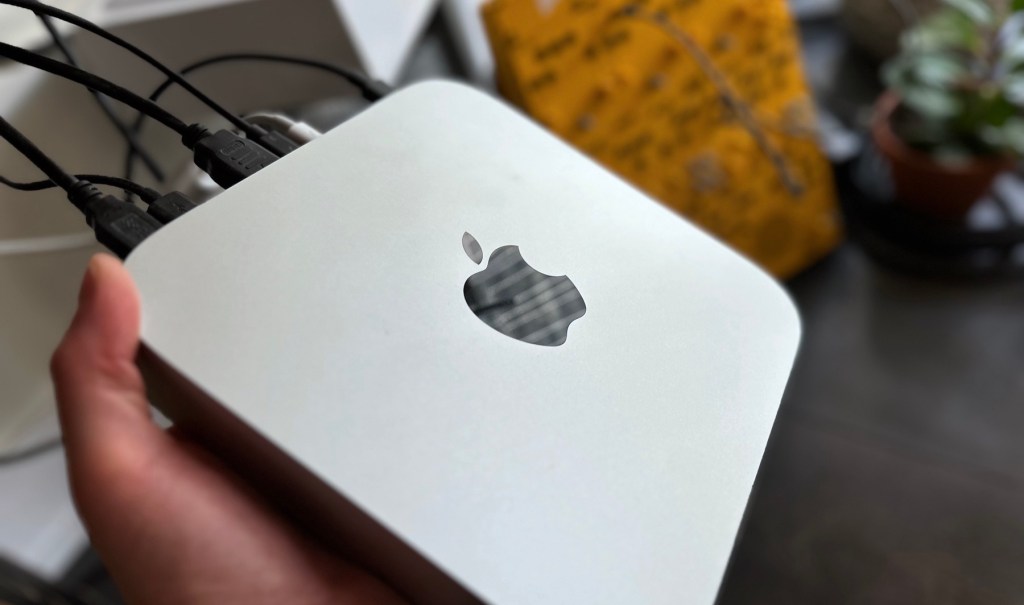
The compact design of the Mac mini and just enough I/O for my needs, makes for a versatile machine that can hide under the desk, or rest neatly on top without getting in the way or creating an overall cluttered look. I will certainly be finding a more permanent under-desk solution for it once I finish designing my new workspace desk and finally move it all into a more permanent home, but it’s easy enough to deal with until then, and I might indeed be considering a jump to whatever the latest Mac Studio is at the time.
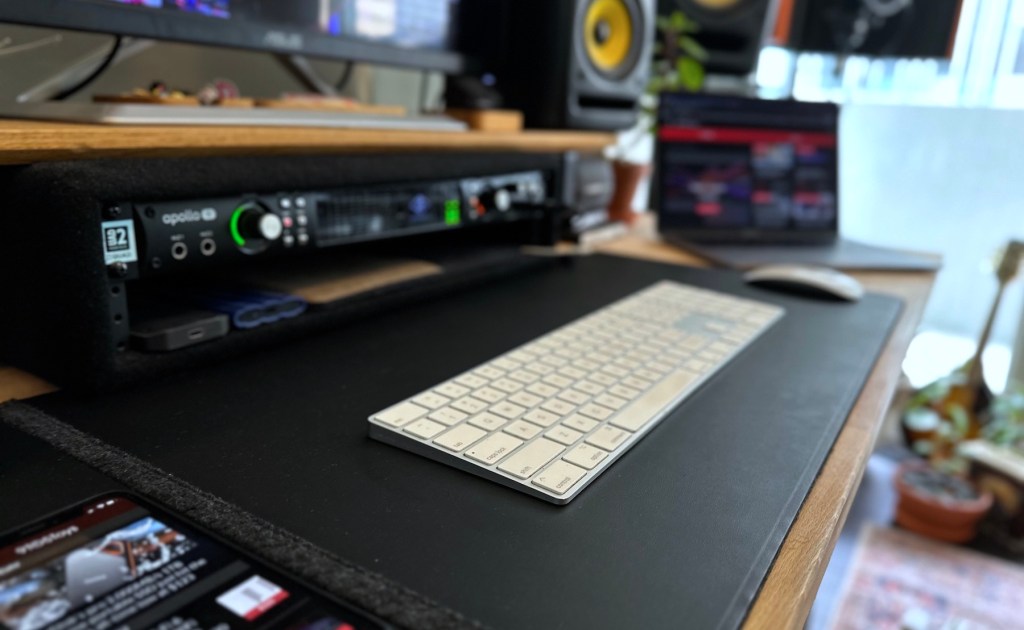
Mouse and Keyboard
When it comes to peripheral input devices for the Mac mini, I’m certainly not going to impress or surprise anyone the way Rikka’s custom-built pocket monster Trainer setup does. A full-size Apple Magic Keyboard with the Num Pad – I could do without the num pad extension on a daily basis here at 9to5Toys, but it does come in handy with Logic Pro and has a physical calculator otherwise, so it will likely be sticking around for a while. While I certainly understand the appeal of a more clunky and clicky keyboard, I, unlike some, have not yet been seduced by the larger modern throw-back keys and still prefer the thin streamline design of the Apple keyboard. That same sentiment carries directly over to my plain vanilla Apple Magic Mouse, I have just always loved it – despite it still seemingly literally crazy to me that you have to flip it over like an unfortunate turtle and wait for it to charge to use it again – including the way it feels under my hand, functions, and looks.
Depending how the overall aesthetics stack up in my new space, I might very well move over to the Black and Space Gray set.
Monitor
I don’t do any gaming on a computer monitor in my office, don’t really care much for the highest quality display in front of me, and tend to save money with my monitor choices. As someone who just doesn’t appreciate the latest and greatest highest-resolution computer monitor just for browsing the internet, doing research, and watching the odd YouTube video, a simple workhorse 1080p monitor is more than capable of keeping up with my needs. This simple $230+ ASUS 32-inch model sitting in front of me right now blends in just enough to not stand out, certainly didn’t break the bank, and is really nothing to write home about. I have a higher-end Dell option with one of those fancy adjustable arms and a thin sliver bezel that is far newer, more modern-looking, and almost certainly produces a better picture gathering dust in the closet, and that’s where it will remain until I absolutely need it so I can save and spend my money on the stuff that really matters to me; a natural wood desk and our next category, the audio.
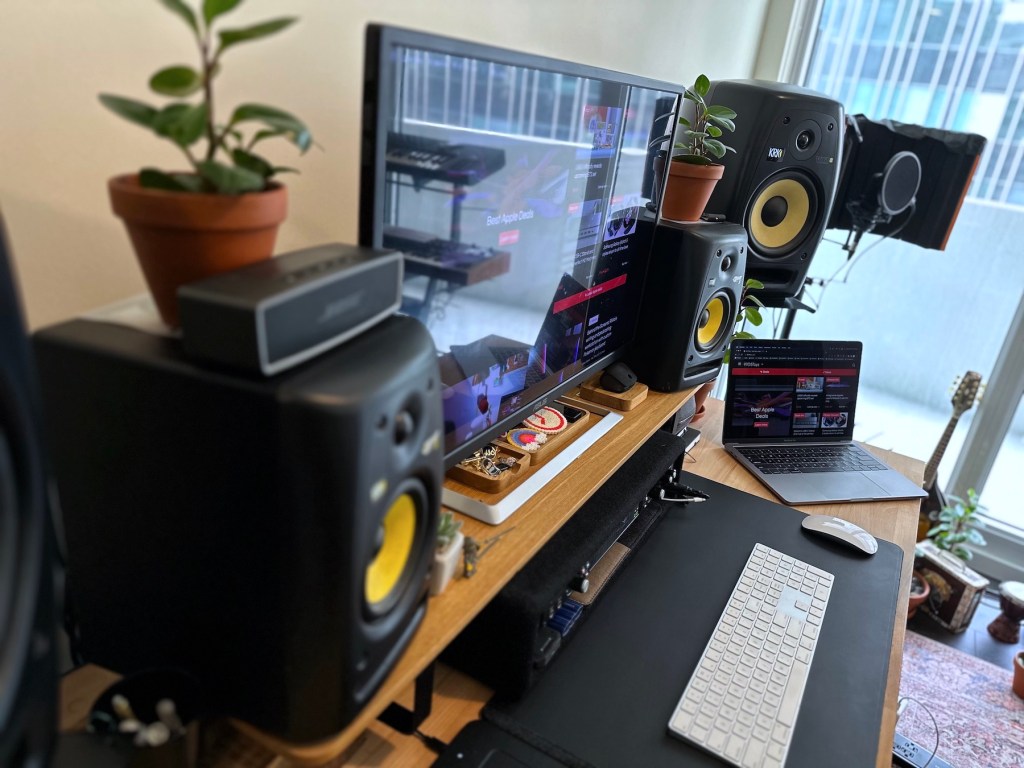
Audio – speakers
High-quality computer speakers or some of the those multimedia content creator speakers are just fine. I know folks who use them, have spent more than my fair share of long nights and weekend sessions using them, but for my money and ears, the professional-grade active powered studio monitors are a must.
As of right now, I’m using a set of KRK VXT8 monitor setup atop speakers stands resting on either side of my desk. But you’ll also find a smaller pair of KRK Rockit 5 speakers right up on the Oakywood Oak Desk Shelf on either side of the monitor. In other words, one hardcore pair of larger 8-inch studio monitors you would find atop the recording desk in most recording studios and a set of prosumer 5-inchers that deliver a quieter and more intimate sound when needed.
Do I need two sets of professional studio monitors? Well no, probably not. But do I absolutely love having the option to flip the output of my Mac mini between them at the push of a button on my audio interface? Yes, I very much do.
One thing to keep in mind with speakers or monitors like the KRKs – they really last. I am pushing a decade here with these speakers and they still sound fantastic, work flawlessly, and impress just about anyone who gets a chance to hear them. They are not cheap, especially the VXT8s which can fetch as much as $800 per side, but if you apply the old cost per wear (or I guess years of use in this case), they are some of the most economical and value-packed purchases I have ever made.
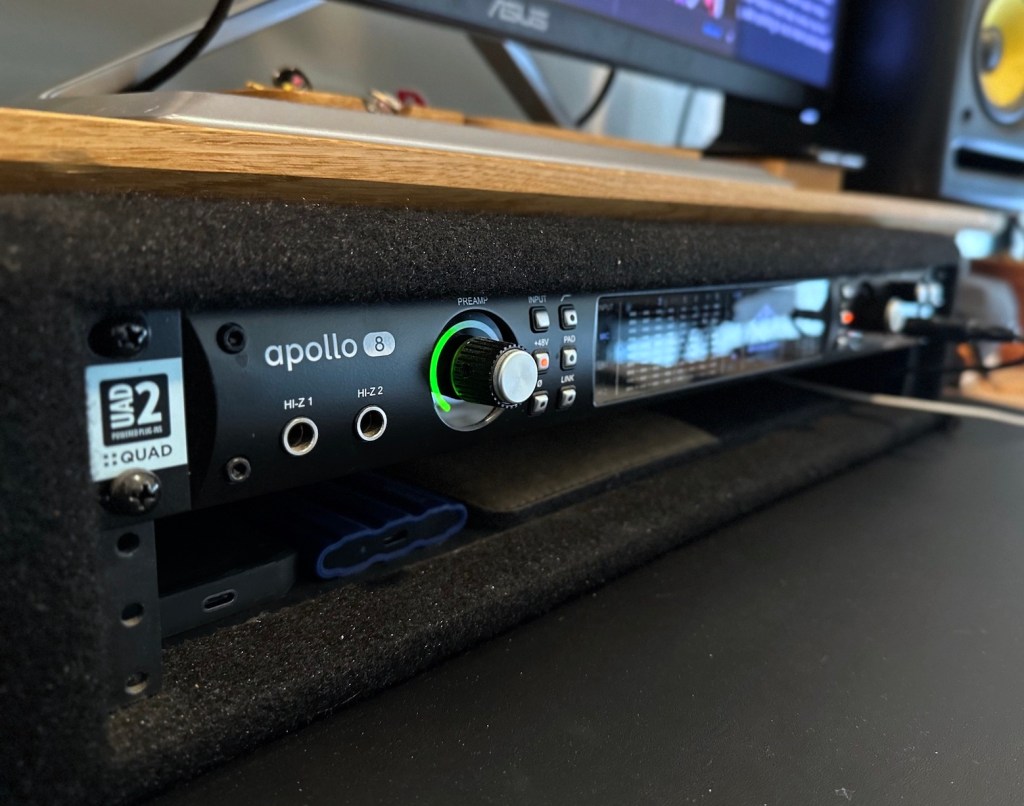
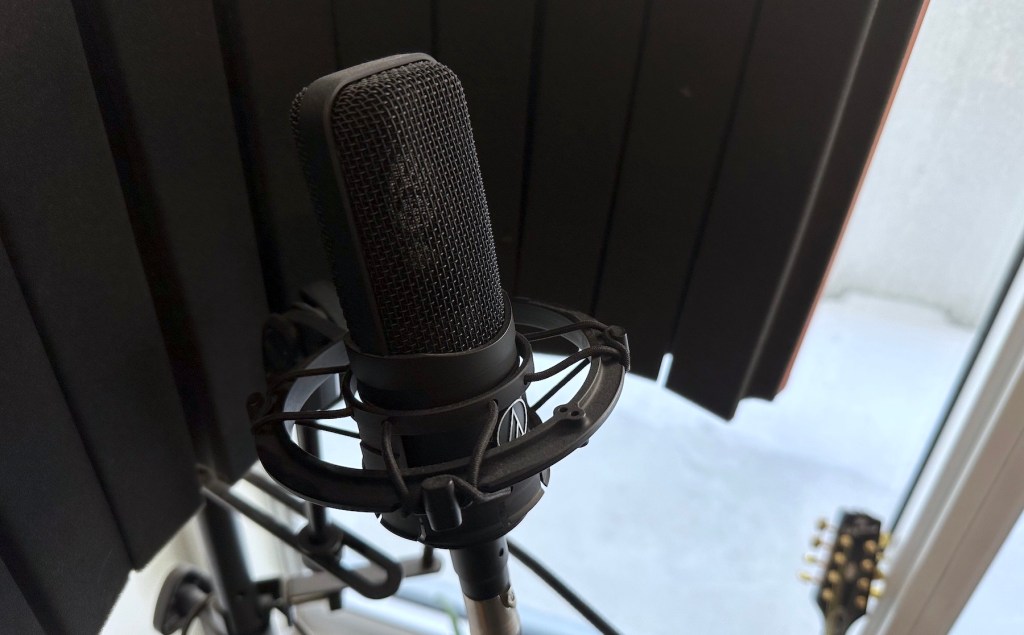
Audio – interface/microphone
Another place where I really get my money’s worth is in interface and microphone department. I do a ton of music recording in my free time, both professionally and recreationally, and so that’s where the seemingly overkill Universal Audio Apollo 8 interface comes into play. We are focusing on my workstation as opposed to the recording end of things (which we will likely visit as part of a second feature down the line here) right now, so for the purposes of this Behind the Screens feature the interface really comes in handy for two things; audio output to my speakers and XLR input for a microphone.
I certainly make good use of its ability to quickly flip the output of the Mac mini from the smaller to the larger KRK speakers with the click of the front-mounted switch, not to mention a hardwired set of headphones, but it is in many ways a bit much in the I/O department – I just don’t need eight+ inputs for work these days. Even still, this wonderful sounding and particularly expensive machine will remain in my setup until it dies.
And just for those wondering, I use an Audio-Technica 4050 microphone on a regular basis for voice overs, music demoes, and things of that nature – a microphone I would recommend to anyone looking to scoop something up in its price range – as well as a Neumann TLM102 for more serious production work.
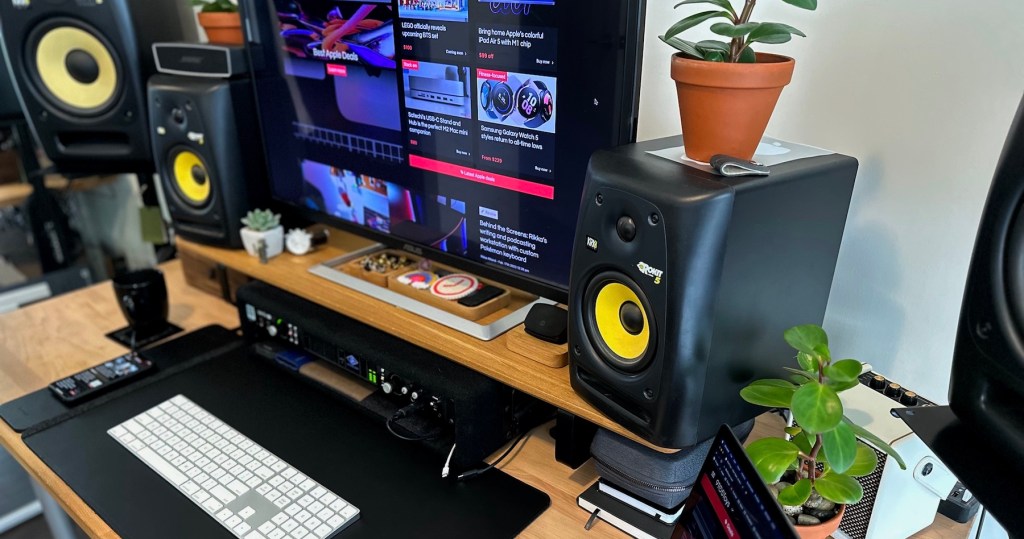
Desk/Setup/Accessories
As of right now, my entire setup sitting atop a temporary IKEA desk that has been crudely modified with an under-desk cage like shelving unit and some of those hooks for headphones and cables – just anything to keep the cables up off the floor as much as possible until a more permanent solution is ready.
I have a few Amazon Basics surge protector power bars connected to wall outlets and directly mounted in this under-desk cage. There are several more cables here by comparison to your typical setup due to the larger audio interface that connects two sets of active speakers (that’s eight cables alone with the power and audio), a microphone, two electric guitar inputs, a series of synthesizers and some MIDI runs for controls and the like (again, we will visit this setup down the line in particular). You’re looking at roughly 16 different cables (power and audio) without even factoring in charging cables, MagSafe leads for iPhone charging, and anything that connects to the Mac mini (the interface itself, a couple USB-C portable SSDs, the HDMI cable, and power), so something to keep it all organized and hidden away is a must here.
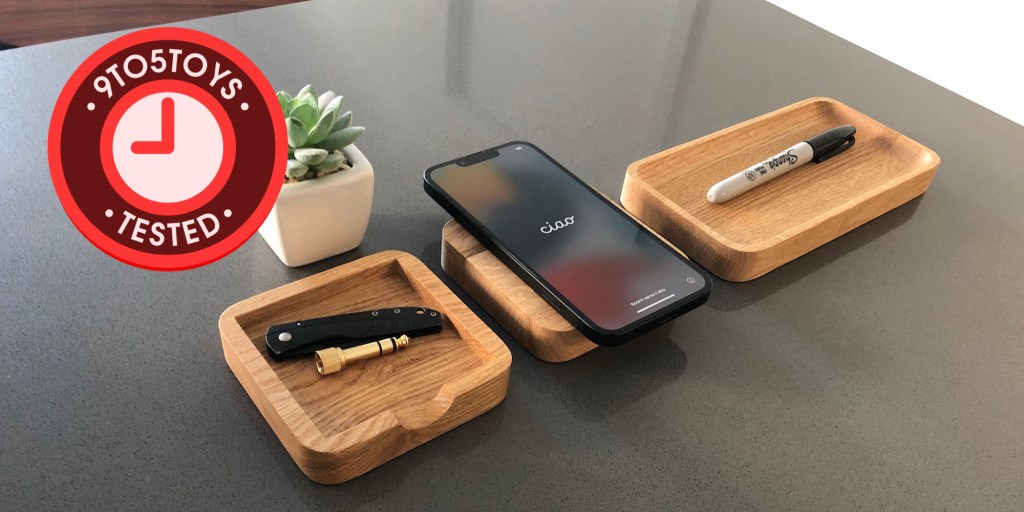
Atop the desk, Oakywood’s wooden OakyBlocks accessories are the main feature in the organization setup. This includes the oak desk shelf and wooden Qi charging pad I reviewed previously as well as a pair of wood trays for organizing smaller accessories and the like.
Tested: Hands-on with Oakywood’s 15W wireless wooden magnetic Qi charger
Tested: This handmade oak and walnut monitor stand shelf takes your desk to the next level
I am a big fan of these Oakywood accessories – the wooden finish is wonderful and the cork bottom adds a notable artisan touch and attention to detail I very much appreciate. I will continue to use them well into the future (although I might consider moving over to the darker walnut wood treatment to match my new desk at some point) and be sure to check out my hands-on review of the brand’s latest wooden MagSafe charging stands while you’re at it.

You’ll also notice Journey’s black MagSafe charging desk mat front and center here – it has been a wonderful tool to have directly in front of me for months at a time and you can get a complete rundown of the user experience in my review, but I still haven’t decided if it will remain a permanent part of my setup. For now, it covers the not so pretty IKEA desk but it might not make the cut when I get a beautiful piece of natural Walnut wood for the desktop in the coming months.
Tested: Journey’s desk mat combines a vegan leather work surface with MagSafe charging
FTC: We use income earning auto affiliate links. More.






Comments